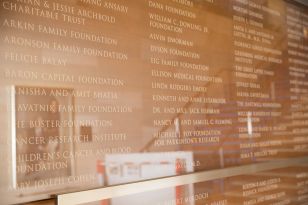Identifying Social Determinants of Health in Brooklyn
A study from researchers at NewYork-Presbyterian and Weill Cornell Medicine identified economic and social conditions impacting individual and group differences in health status, known as social determinants of health, in Brooklyn and top barriers to cancer care – insights that the authors hope can inform health care organizations on how to better reach the communities they serve, reduce cancer disparities and support advocacy for needed policy changes.
“Everyone across the country is grappling with how to address social determinants of health,” said lead author Dr. Erica Phillips, an associate attending physician at NewYork-Presbyterian/Weill Cornell Medical Center and associate director of community outreach and engagement at the Sandra and Edward Meyer Cancer Center at Weill Cornell Medicine. “Our study shows how we might disentangle and act on the drivers of health inequities.”
The study, published in the winter issue of Ethnicity and Disease, solicited feedback from community members in neighborhoods with high incidence of cancer across Brooklyn and found that significant barriers to care include economic stability, education, and community and social context (like stigma, bias and discrimination, eroding support systems and cultural misconceptions, according to those interviewed).
“What came across resoundingly was the impact of economic instability as the greatest barrier to cancer screening and treatment. It impacts people’s access to transportation, to food and to medicine,” said Dr. Phillips, who is also an associate professor of clinical medicine at Weill Cornell Medicine. “It impacts their ability to take time off work to attend to their own health.”
Study Design
Researchers focused on Brooklyn because of its high cancer mortality rates compared with other areas served by NewYork-Presbyterian and Weill Cornell Medicine. From there, they used publicly available data and hospital admissions to NewYork-Presbyterian Brooklyn Methodist Hospital to pinpoint four neighborhoods with the highest incidence and mortality from cancers of the breast, cervix, colon, lung and prostate, all of which are amenable to early detection and treatment. These neighborhoods are Crown Heights, Bedford-Stuyvesant, Coney Island and Flatbush.
The Sandra and Edward Meyer Cancer Center at Weill Cornell Medicine, in collaboration with the Office of Community Affairs at NewYork-Presbyterian Brooklyn Methodist Hospital and the Cornell Center for Health Equity , then recruited community participants for roundtable discussions. They invited a diverse stakeholder group comprised of policy makers, community-based clinicians, patients, faith leaders, and leaders of community-based organizations working on issues from immigration to food access to participate.
In each neighborhood, the researchers held structured, facilitated roundtable discussions with the community stakeholders to reach consensus around the most important social determinants of health. In the fall of 2019, researchers also embarked on individual level surveys of residents’ attitudes and beliefs about cancer and its treatment in their respective community (the last 200 were held by phone after COVID-19 hit the city).
Barriers Revealed, Interventions Pursued
Community participants identified specific concerns within each of the three overarching areas. Regarding economic stability, they highlighted the impacts of cancer screening and treatment on wages and employment; competing financial priorities; and the inability to afford medical expenditures or costs related to receiving care.
Regarding education, particular concerns revolved around challenges preventing informed health decisions due to the lack of actionable and clear health information. Participants also explained the impact of “community and social context,” discussing stigma, bias, and discrimination in health care; cultural beliefs, and the erosion of support systems.
To address the financial challenges related to cancer care, Dr. Phillips points to changes that would reduce the need to take time off work, such as extended clinic hours, flexibility in scheduling, and setting up interdisciplinary appointments so that a patient can meet with the entire health team at one time, rather than returning for repeated appointments.
But she also noted that as of 2018, New York state law prohibits cutting wages for public sector workers who take time off work for any cancer screening. Although employers don’t often advertise that—health care institutions could.
In addition, Dr. Phillips notes the importance of health systems becoming more engaged as policy advocates. “Policy reform is key to addressing the underlying causes of health disparities,” said Dr. Phillips. “In advocating for their patients through an evidence-based policy agenda, health care systems could be powerful allies to communities that suffer high burdens of cancer.”
This includes making high-quality health care more affordable, particularly as innovative new diagnostics and treatments become available. Dr. Phillips is collaborating with organizations to talk to state and city officials to make innovations like precision medicine and biomarker testing more affordable for patients.
In response to the study findings, the team has designed and implemented an eight-week health education program that targets heart disease and cancer in the four communities. The curriculum incorporates personal stories and short videos, can be taught in person or online and is led by a trained team of community-based health educators. The study noted that in a review of interventions for health promotion and disease prevention, lay health educators support a sense of connectedness and patient engagement in their own health care.
To date, relatively few U.S. physician practices (15.6%) and hospital systems (24.4%) universally screen patients for multiple social needs, according to the study. Yet addressing social determinants of health is essential for improving overall health and reducing health disparities that are embedded into systems of social and economic disadvantage.
“Understanding local social determinants of health not only indicates what can be done locally, but also enables health systems to identify the larger policy issues they should advocate for, which individual providers cannot change on their own,” Dr. Phillips said.
“We are grateful to the hundreds of community leaders and stakeholders who came together to share their input and help inform this work, which we hope will make a difference to the health of our communities.”



